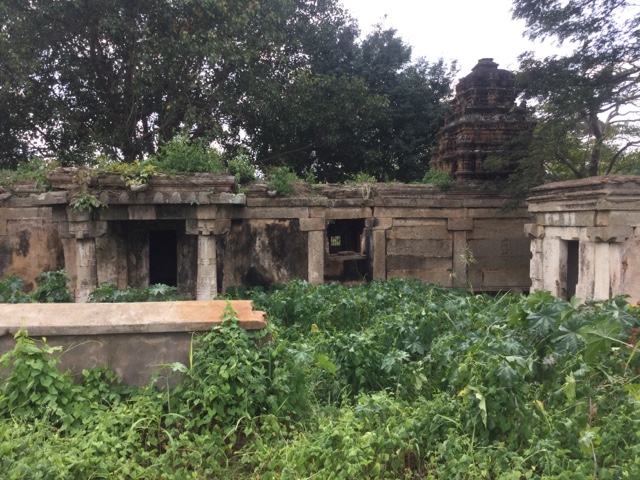Devoured by the jungle , a nameless memory .
Beemanakolli ruins
On a visit to Antharsanthe ( HD Kote Taluk , 70 Km from Mysuru ) , chitchat with lay villagers about this and that throws up an interesting info . Presence of an old temple in Beemanakolli village referred to as Cholara-Gudi and Kallina -Gudi ( " chozha temple " and " Stone Temple" )by villagers. The term Chola is just an euphemism for " Ancient" in these parts.
Suitably fired up, we promptly land in the obscure Beemanakolli village , but finding that stone temple turns into a wild goose chase . It is just a tiny town with a colourful , rebuilt , 400-year old temple to Veerabhadra and a bunch of houses in two or three streets. Rest are fields and orchards on one side and the backwaters of Kabini Reservoir on the other . Where can an ancient monument hide ? Round and round we go , finding no spire or wall that can indicate a halfway ancient stone temple.
Finally , the priest of the Veerabhadra temple gets kind enough to guide us . He takes us through a barely visible beaten path meandering through a sprawling Oil Palm plantation belonging to the State Forest Department. Unless pointed out , the path, so totally camouflaged with wild growth , remains invisible .
Have to , literally ,plough through higher-than-the-head bushes . Untangle vines that hang about like a curtain , obstructing view . Gingerly step into high undergrowth that carpet the uneven terrain . A deathly silence pervades the muggy air ,not broken even by the chirp of an insect or bird. When a slight breeze rustles , it sounds like something slithering underfoot .....
No boots , no gloves , no bug repellent, not even a useful stick ...in hindsight it seems a foolhardy jaunt. But it dint strike the mind so at that time....cutting through the vegetation with an umbrella , we wade towards the banks of the reservoier, unable to guess what is in store .
Finally ......gasp ! Its looks older than old . Ruined beyond redemption .
The guiding priest calls it Padmavathi Temple , but there is no presiding idol . He informed us that when Kabini Dam was built , the main deities of temples lying along the path of inundation were removed to safer sites. Moolamurthis from this temple were sent to Kenchanahalli nearby. After water level of the reservoir was regulated, the temple escaped drowning, but worship could not be revived because Kenchanahalli refused to return the Gods ! So the place just went to seed. Forgotten.
History of the temple ? " No idea ! " says the poor man , rather apologetically.
Onward then, to explore the structure in front of us, being devoured by the hungry jungle .
The short stairway ( sopana) with makara balustrades is untrustworthy under the foot , wobbling and giving way . Climbing the mukhamantapa , surprised to find signs of usage : ash from old fires , vestiges of garlands , dried , brittle and brown , charcoal grafitti scrawled on the walls , a small faded picture of Ganesha with broken glass and termite eaten frame . The female figures flanking the doorway are so heavily limewashed and mouldy that the features are unclear . Only a very close scrutiny reveals a gajalakshmi lintel .
The flooring of the main cell is completely gone and only rubble remains. The carved pillars remain in place and the dwarapalakas guard an empty garbhagriha.
Animal figures on the pillars include a Camel , a horse , elephant and hamsas. Other pillars show avatars of Vishnu .
The small porch on the right of the central hall has Jina murthis carved on the pillars . The name Padmavathi and these murthis point to it having been a Jaina shrine once , yet , the interiors declare it to be a vaishnava shrine .
There's a smaller cell away from the main structure, which connot be reached because of the waist deep vegetation . Beyond the crumbling compound wall is Kabini , shimmering bright blue .
The neighbouring shrine , in a slightly better condition , whitewashed , with no stone carvings but with nice stucco yakshis along the top , houses a small marble Jina murthy on a wooden table in the sanctum . Here too, there is no sign of regular worship.
Our guiding priest tells us some Jains do visit this second shrine once in a bluemoon , but the first one is given over for Nature to reclaim .
The Mysore Archeological Records have not been of much help in identifying the story of this temple .
-----------------------------






Comments